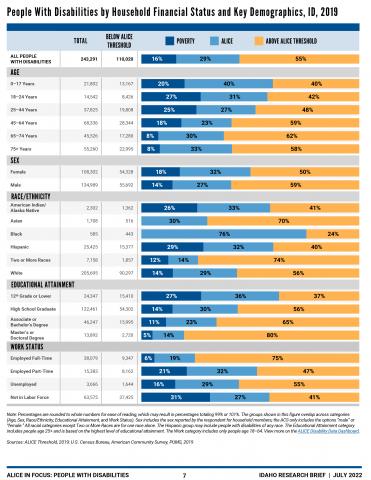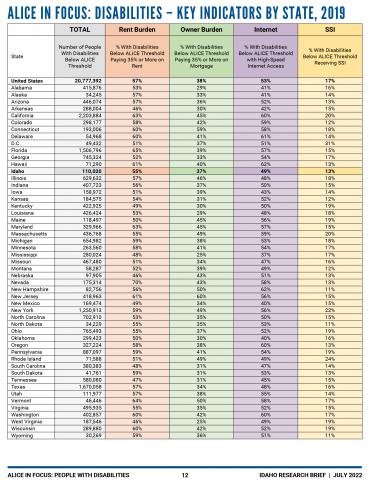
FINANCIAL HARDSHIP AMONG PEOPLE WITH DISABILITIES:
IDAHO
Having a disability — whether apparent or non-apparent, physical or cognitive — can be a substantial barrier to financial stability. Yet traditional economic measures hide the full extent of financial hardship for the 14% of people in Idaho (243,291) who have a cognitive, hearing, vision, or ambulatory disability, or one that makes self-care or independent living difficult. According to the Federal Poverty Level (FPL), 16% of people with disabilities in Idaho (38,583) lived in poverty in 2019. However, United For ALICE data shows that another 29% (71,437) — almost twice as many — were also experiencing financial hardship, in households that earned above the FPL but not enough to afford the basics in the communities where they lived.
The reality is that nearly half (45%) of all people with disabilities in Idaho lived in a household with income below the ALICE Threshold of Financial Survival in 2019. This includes households in poverty as well as those who were ALICE: Asset Limited, Income Constrained, Employed. ALICE households don’t earn enough to afford the essentials of housing, child care, food, transportation, health care, a smartphone plan, and taxes — the basics needed to live and work in the modern economy (see Key Terms). This Research Brief shows that there are people with disabilities below the ALICE Threshold of all ages, races/ethnicities, and educational levels, in a variety of living arrangements and employment situations. People with disabilities below the ALICE Threshold live in all communities across the state (PUMAs), at rates ranging from 35% in northwestern Kootenai County to 60% across Bonner, Latah, Shoshone, Boundary, Benewah, and southeastern Kootenai counties.
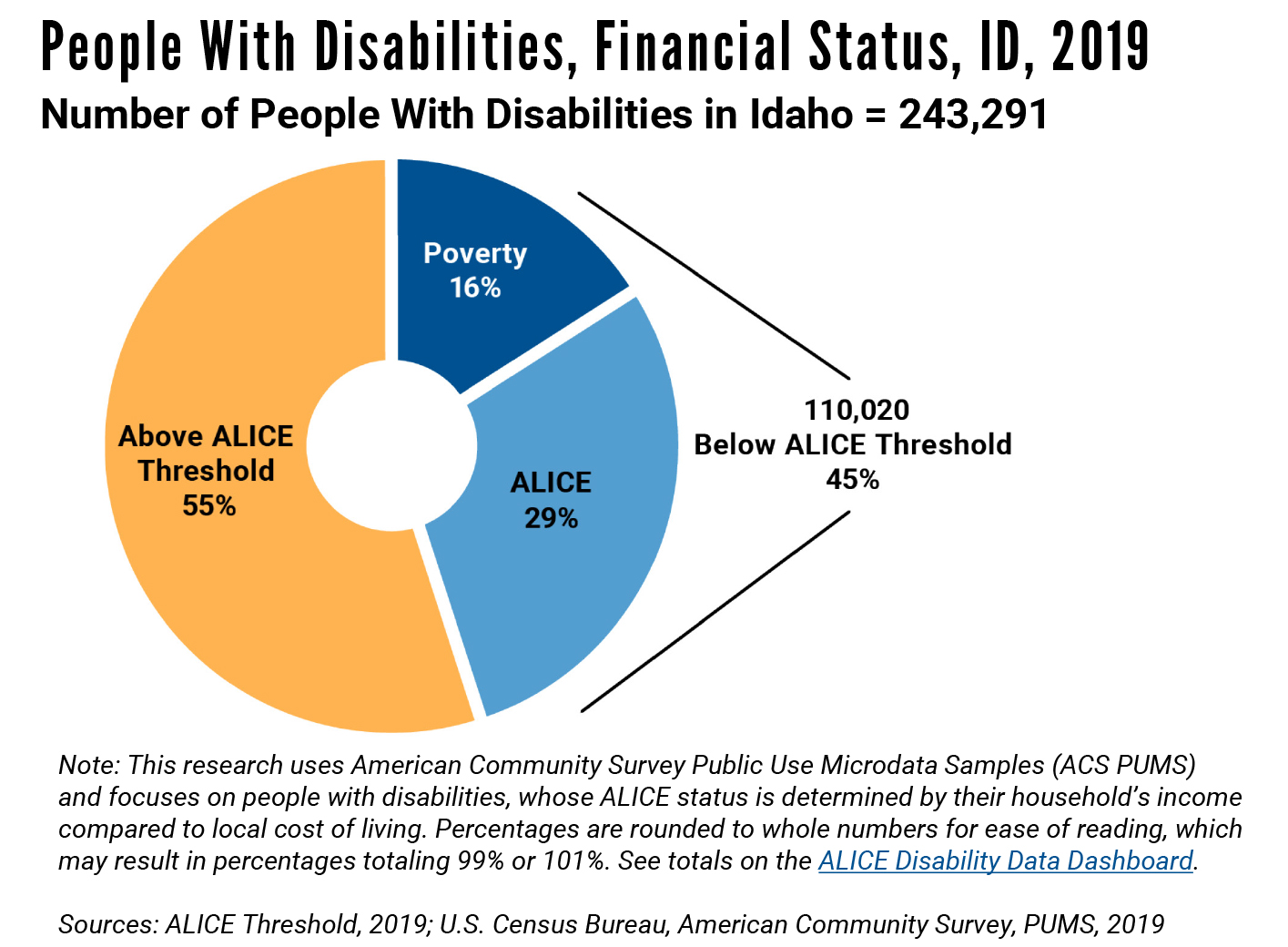
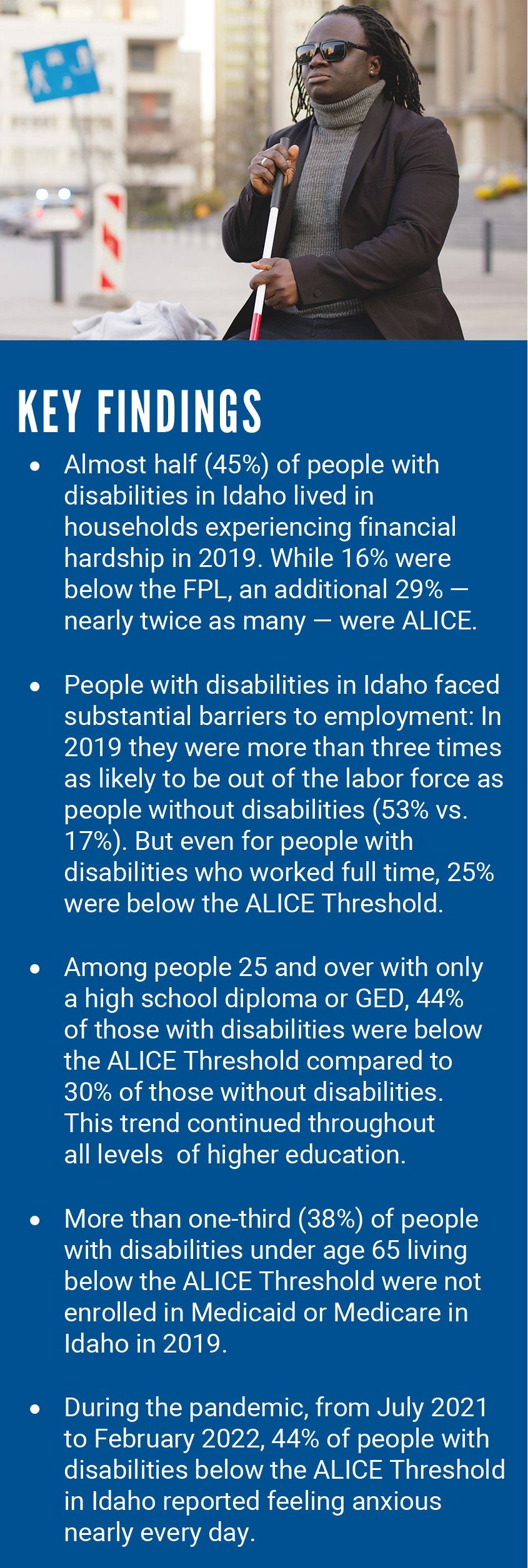
The task of defining disability is complex, dynamic, multidimensional, and contested. How disability is defined has significant implications for people with disabilities, including determining who has access to federal programs and protections under the law. The legal protections outlined in the Americans with Disabilities Act (ADA) give one of the broadest definitions, including anyone with a “physical or mental impairment that substantially limits one or more major life activities, a person who has a history or record of such an impairment, or a person who is regarded by others as having such an impairment,” which also covers people with chronic health conditions such as cancer or diabetes, and those with service-related disabilities (military veterans will be the subject of the next ALICE in Focus Research Brief). But eligibility definitions, like the criteria used for Social Security disability-related benefits, are often more limited. Individual experiences also vary greatly, and some people do not want to disclose their disability due to real or perceived stigma.
In this ALICE in Focus Research Brief, “people with disabilities” include those who have an ambulatory disability, a cognitive disability, a hearing or vision disability, or a disability that makes self-care or independent living difficult, as reported in the 2019 U.S. Census Bureau’s American Community Survey (ACS). This ALICE research uses the ACS definition and dataset because it is the only source that includes both disability status and the information needed to determine a person’s ALICE status — their household composition, income, and location. The ACS’s questions about disability — outlined in the table below — are asked for each member of a household. Of people with disabilities in Idaho in 2019, slightly over half had one of the six types of disability listed below (141,705), but a significant number (101,586) had two or more. People with two or more disabilities were more likely to be below the ALICE Threshold (48%) than people with one disability (43%) and people without disabilities (33%).
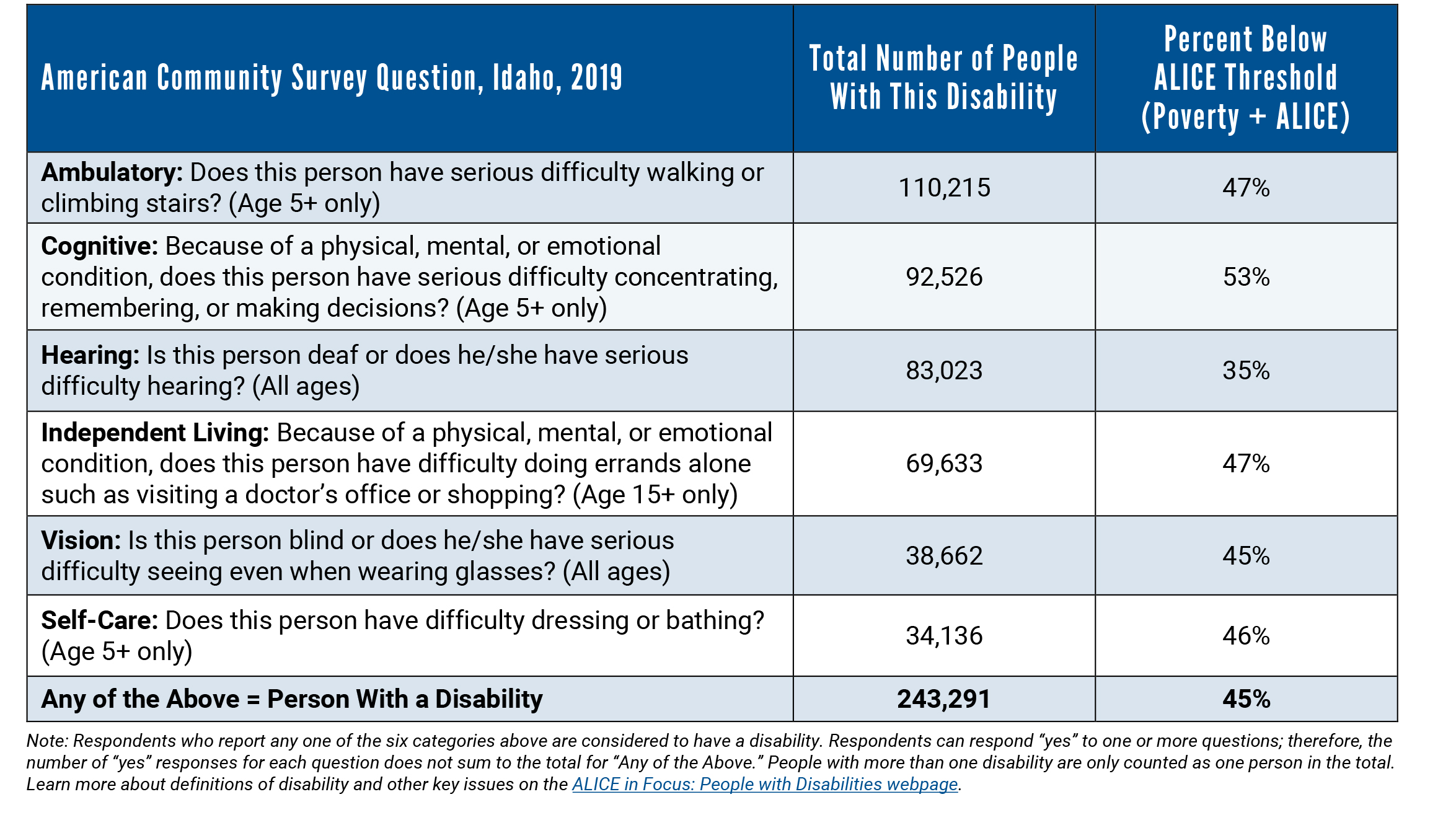
The extent of financial hardship for people with disabilities, as outlined in this Brief, is substantial; yet the degree of hardship is likely even higher than estimated by the ALICE measures. There are two reasons for this. First, the Household Survival Budget includes the cost of household basics for all households, yet research shows that costs for households that include someone with a disability are higher than average. Second, just over 8,800 people with a disability in Idaho were excluded from the ALICE analysis in 2019 because they lived in Census-defined “group quarters”: over 7,100 in institutional group quarters (such as nursing homes or correctional facilities) and nearly 1,700 in non-institutional group quarters (such as group homes, college dormitories, or military barracks). Because the cost of living in these settings differs substantially from the cost of living in a household, their ALICE status cannot be determined. This Brief also does not include people experiencing homelessness, who are not counted in the ACS.
DEMOGRAPHICS
People with disabilities span all categories of age, sex, race/ethnicity, national origin, living arrangements, work status, and educational level. In general, people with disabilities are more likely to have income below the ALICE Threshold than people without disabilities. At the same time, certain demographic groups — including those that face systemic racism and sexism — have higher rates of disability. This intersectionality also increases rates of financial hardship, especially for people with disabilities who are female; Black, Indigenous, and other people of color; and/or born outside of the U.S., as well as for other groups — like LGBTQ+ individuals — who are not fully represented in the ACS data.
There are people with disabilities of all ages, though disabilities are more common in older people. In 2019, 5% of children under age 18, 12% of people age 18–64, and 36% of seniors (age 65+) in Idaho had one or more disabilities. However, children with disabilities were more likely to live in households below the ALICE Threshold than adults or seniors with disabilities. In Idaho in 2019, 87% of children under age 5 with disabilities and 59% of children age 5–17 with disabilities lived in households below the Threshold, compared to 44% of adults (age 18+) with disabilities. Coupled with caregiving demands, the cost of raising children and the added expense of resources often needed for children with disabilities can limit a parent’s earning potential and overall household income. This is especially true for families who are not eligible for Medicaid, have limited private insurance coverage, and/or are not eligible for publicly-funded programs such as Early Intervention that provide therapies and services for free or at a reduced cost based on child and family need. Children with disabilities were also more likely to live in households below the Threshold (60%) than those without disabilities (45%).
Seniors (age 65+) with disabilities were less likely to be below the ALICE Threshold than younger adults (in part due to Social Security and Supplemental Security Income).
The type of disability also varied by age in Idaho. For children and adults under the age of 65, the most common was a cognitive disability (in 75% of children with disabilities over the age of five and 47% of adults with disabilities age 18-64). For seniors, the most common was an ambulatory disability (for 55% of seniors with disabilities).
In 2019, the ACS included only one question on sex with only two options — “male” or “female” — and respondents were not able to report gender identity or sexual orientation. The ALICE data reflects these limited options.
Overall, in Idaho, females were slightly less likely to have a disability than males (12% vs. 15%), which is the opposite of the national trend. However, females were more likely to have disabilities that often occur in older age, such as an ambulatory disability or a disability that makes self-care or independent living difficult. This is partly a reflection of females’ longer life span — average life expectancy in the U.S. is 80 years for females vs. 74 for males — and the higher prevalence of disability among older seniors (age 74+).
However, for all categories of disability except for vision disability, females with disabilities were more likely than males to be below the ALICE Threshold in Idaho in 2019. Overall, 50% of females with disabilities were below the ALICE Threshold compared to 41% of males with disabilities, demonstrating the compounding impact of systemic inequities by both disability status and sex.
While the ACS does not include data on this topic, additional research shows the intersectionality between gender identity, sexual orientation, and disability. People who identify as lesbian, gay, bisexual, or transgender are more likely to report having disabilities and facing financial hardship. LGBTQ+ people with disabilities face challenges that can undermine wellness and financial stability: employment discrimination, bullying and harassment in school, higher rates of mental health conditions, and limited access to LGBTQ+ inclusive health and community services.
In 2019, the largest number of people with disabilities below the ALICE Threshold in Idaho were found in the largest racial/ethnic populations: People with disabilities below the Threshold were predominantly White (90,297) and Hispanic (15,377). Yet Black, Hispanic, and American Indian/Alaska Native people with disabilities were disproportionately ALICE — a result of persistent racism, discrimination, and systemic barriers that limit their families’ access to resources and opportunities for financial stability. In 2019, 59% of American Indian/Alaska Native, 60% of Hispanic, and 76% of Black people with disabilities lived in households below the ALICE Threshold, compared to 30% of Asian and 44% of White people with disabilities.
In Idaho, people who identify as being two or more races had the highest rate of disability at 17%, and Black people had the lowest rate of disability at 5%.
Across most racial/ethnic groups, people with disabilities in Idaho were more likely to be below the ALICE Threshold than those without disabilities (see table below). However, the gap in financial hardship by disability status differed by race/ethnicity. Among American Indian/Alaska Native people with disabilities, 59% were below the Threshold compared to 36% of people without disabilities — the largest gap of any racial/ethnic group. And while the gap in financial hardship by disability status was smaller for other groups, some of the overall rates were higher. For example, 76% of Black people with disabilities were below the Threshold, compared to 58% of Black people without disabilities.
The way schools address the educational needs of students with disabilities can contribute to the perpetuation of educational gaps by race/ethnicity. There were substantial differences by race/ethnicity in how K–12 public school students were identified as having a disability under the Individuals with Disabilities Education Act. Nationwide, compared to all students with disabilities, Black students with disabilities were more likely to be identified with emotional disturbance or intellectual disability and more likely to receive disciplinary removal; Asian students with disabilities were more likely to be identified with autism and graduate high school; and White students with disabilities were more likely to be served in a general education classroom.
English-speaking ability, and whether an individual was born outside of the U.S., also have an impact. In Idaho, people with disabilities born outside of the U.S. were more likely to be below the ALICE Threshold (51%) than people with disabilities born in the U.S. (45%). Both rates were considerably higher than for people without disabilities born in the U.S. (32%). Rates were even higher (83%) for people with disabilities in Idaho living in a family with limited English-speaking ability.
Research shows that people with higher academic degrees generally have greater earning power, but also that low income reduces educational opportunities, especially for graduate and professional degrees. Having a disability adds yet another dimension.
Among people age 25 and older in Idaho, people with disabilities were less likely to have graduated from high school or to have completed a GED (88%) compared to people without disabilities (93%) in 2019. People with disabilities in this age group were also less likely to complete post-secondary education: 29% of people with disabilities attained an associate degree or higher, compared to 43% of people without disabilities.
Most notably, across all educational levels from high school on, people with disabilities were more likely than those without disabilities to be below the ALICE Threshold. For example, 44% of people age 25 and older with disabilities in Idaho who graduated high school but didn’t complete post-secondary education were below the ALICE Threshold in 2019, compared to 30% of their peers without disabilities.
Educational disparities by race/ethnicity are well known, and having a disability expands these gaps further. For example, in 2019, 9% of Hispanic people with disabilities in Idaho had a bachelor’s degree or above, compared to 19% of White people with disabilities.
There were also substantial disparities in financial hardship by sex and educational attainment: At every educational level, females with and without disabilities were more likely than males to be below the ALICE Threshold.
Employment: In Idaho in 2019, there were 57,128 people with disabilities age 18–64 in the labor force, accounting for 7% of the total labor force population and making up 47% of people with disabilities in that age group. Whether working full or part time, they were more likely to be below the ALICE Threshold than people without disabilities: 25% of full-time workers with disabilities were below the ALICE Threshold compared to 20% of full-time workers without disabilities. For people with disabilities who worked part time, the rate of financial hardship was 53%, higher than for part-time workers without disabilities (37%).
Rates of employment and wages for people with disabilities in Idaho vary based on the type of disability, as well as age, sex, race/ethnicity, and educational attainment. Current laws also permit employers to pay some workers with disabilities less than minimum wage: In Idaho, as of April 1, 2022, 70 workers earned a subminimum wage.
For workers in Idaho with a high school degree, 35% of people with disabilities were below the ALICE Threshold, compared to 28% of people without disabilities. And while the overall rate of hardship decreases with higher education, the gap in rates between people with and without disabilities remains. In 2019, for workers in Idaho with an associate or bachelor’s degree, 24% of employed people with disabilities were below the Threshold compared to 17% of workers without disabilities. For people with an advanced degree, the rates were 14% below the Threshold for those with disabilities and 13% for those without.
Overall, people with disabilities below the ALICE Threshold in Idaho were concentrated in occupations with low median hourly wages. For example, in Idaho in 2019, 73% of people with disabilities working as a cashier, earning a median wage of $12.37 per hour, were below the ALICE Threshold, in one of the most common occupations for people with disabilities below the Threshold. Similarly, 75% of people with disabilities working as a cook (median wage of $11.15 per hour) and 63% of people with disabilities working as an office clerk (median wage of $15.37 per hour) were below the Threshold.
Many people with disabilities rely on direct care workers or direct support professionals, who provide support for daily living and other essential activities. For years, both fields have faced significant challenges hiring and retaining staff, a situation made even more difficult by the pandemic as providers compete with offers of less demanding entry-level work at higher wages. For example, in the direct care field, made up of workers who are primarily women, primarily people of color, and often immigrants, staffing challenges were heightened during the pandemic as workers faced increased levels of uncertainty and physical and mental stress. In Idaho in 2019, home health aides and personal care aides earned $11.14 per hour. In addition, many direct care workers themselves have disabilities. In 2019, just over 1,100 personal care aides and more than 370 home health aides in Idaho had a disability, and 34% and 81%, respectively, were below the Threshold.
Unemployment: In addition to physical and cognitive issues that make it difficult for some people with disabilities to work, people with disabilities face other barriers to employment including discrimination, accessibility issues, income and asset limits for public benefits programs, and transportation challenges. These barriers are most apparent in the difference in unemployment rates: In Idaho in 2019, people with disabilities were twice as likely as people without disabilities to be not working, but actively looking for work (6% vs. 3%).
Out of Labor Force: Another 63,575 people with disabilities age 18–64 in Idaho were out of the labor force (not employed and not looking for work). People with disabilities in Idaho were more than three times as likely to be out of the labor force as people without disabilities (53% vs. 17%). And people with disabilities out of the labor force were more likely to be below the ALICE Threshold than people with disabilities in the labor force (59% vs. 34%).
Rates of labor force participation also varied by type of disability in Idaho. In 2019, nearly two-thirds (61%) of people who were deaf or hard of hearing (age 18–64) were working or looking for work. But people with other types of disabilities were more likely to be out of the labor force — 60% of people with a cognitive disability, 73% of people with disabilities that affect a person’s ability to live independently, and 83% of people with disabilities that make self-care difficult.
Seniors: While seniors overall are staying in the labor force longer, only 12% of Idaho seniors with disabilities were in the labor force in 2019, compared to 21% of seniors without disabilities.
People with disabilities who are ALICE live in households of varying size and composition, both of which impact financial stability. Overall, people with disabilities in Idaho tend to live in smaller households. The most common household size for people with disabilities in Idaho in 2019 was two people (compared to four among people without disabilities).
Although people with disabilities age 18–64 in Idaho were much less likely to be employed (44%) compared to people without disabilities (80%), most people with disabilities in this age group lived with at least one working household member (64%).
In 2019 there were 101,723 children in Idaho living in a household where someone had a disability, and 59% were below the ALICE Threshold. When a parent or guardian had a disability, the share of children below the Threshold rose to 64%.
Children with disabilities who lived with two adults were more likely to be financially stable than children living with a single parent or guardian. Despite this, even in households with two working adults, 43% of children with disabilities were below the ALICE Threshold. When only one out of two adults worked, the rate increased to 85%.
Overall, people with disabilities in Idaho were more likely than people without disabilities to live alone. Nearly 45,335 people with disabilities in Idaho lived alone in 2019. People with disabilities who lived alone were more likely to be below the ALICE Threshold (64%) than people with disabilities who lived with one or more other people (41%).
Seniors (65+) lived alone at even higher rates than people age 18–64 in Idaho (23% vs. 10%). Yet seniors with disabilities living alone were nearly twice as likely to be below the ALICE Threshold (62%) than seniors with disabilities living with one or more other people (32%).
ACCESS TO RESOURCES
Despite legislation that prohibits discrimination against people with disabilities in areas such as employment, housing, access to health services, education, and public transportation, people with disabilities still often confront barriers to accessing basic resources. This is especially significant because people with disabilities who are below the ALICE Threshold are much more likely to lack stable housing, quality child care and early education, private health insurance, and home internet access. At the same time, many people with disabilities who struggle to afford the basics are not eligible for public assistance programs. When these household necessities are at risk, there are both short- and long-term cumulative consequences.
Housing instability has a profound impact on overall well-being. A lack of stable housing puts people with disabilities at risk for poor physical and mental health, and may even undermine their ability to live independently in the community. Discriminatory housing practices, a lack of affordable housing, and limited accessible housing stock make it difficult for people with disabilites to find a safe and affordable place to call home.
People with disabilities living in rental housing units and in households that are housing cost burdened (paying more than 35% of income on rent or mortgage) are more likely to experience housing insecurity and are therefore also at greater risk of becoming homeless. Overall, about 29% of people with disabilities in Idaho were in renter households and 71% were in owner-occupied housing in 2019. However, there were differences by age and income:
• For people with disabilities under age 65: Those below the ALICE Threshold lived in renter and owner-occupied housing at simiar rates (50% for both housing types). Those above the ALICE Threshold were far less likely to be renters (21% renters vs. 79% owner-occupied).
• For seniors with disabilities (age 65+): Seniors were more likely to live in owner-occupied housing, but there continued to be a gap by income. Below the Threshold, 29% of seniors with disabilities were renters and 71% were in owner-occupied housing, compared to seniors with disabilities above the Threshold: 12% in renter households and 88% in owner-occupied housing.
By race/ethnicity, in 2019, Hispanic people and people of two or more races with disabilities below the ALICE Threshold in Idaho were more likely to live in renter households than White people with disabilities below the Threshold (54% and 68%, respectively, vs. 41%).
In Idaho, over half (55%) of people with disabilities below the ALICE Threshold living in renter households were rent burdened (paying more than 35% of income on rent), slightly higher than the rate for people without disabilities below the Threshold (50%). In contrast, for people above the Threshold, only 15% with disabilities and 6% without disabilities were rent burdened.
The rates of cost burden were lower for people in owner-occupied households, but there were still large gaps by income in Idaho. More than one-third (37%) of people with disabilities below the ALICE Threshold in owner-occupied households were housing cost burdened (paying more than 35% of income on mortgage, plus utilities, taxes, and insurance), similar to the 35% of people without disabilities below the Threshold. Yet for people above the Threshold, only 5% with disabilities and 4% without disabilities were owner cost burdened.
Access to health insurance is critical to both wellness and financial stability for people with disabilities. Because of Medicare, almost all seniors in Idaho with and without disabilities had health insurance in 2019 (nearly 100% for both groups of seniors). There were lower rates for people under 65, especially those below the ALICE Threshold: 83% of people below the Threshold had some form of health insurance in 2019. People with disabilities below the Threshold were more likely to have health insurance than people without disabilities below the Threshold (86% vs. 82%), which likely reflects the increased need for health services in this population.
People with disabilities below the Threshold in Idaho were slightly more likely to have public insurance (53%), while people with disabilities above the Threshold were more likely to have private insurance (71%).
Medicaid and Medicare, programs designed specifically to provide medical coverage to people with low or fixed incomes and some people with disabilities, were also not fully available to people with disabilities below the ALICE Threshold. Over one-third (38%) of people with disabilities under the age of 65 and living below the ALICE Threshold in Idaho were not enrolled in Medicaid or Medicare. Idaho had the highest percentage of people with disabilities under 65 and below the ALICE Threshold who were not enrolled in Medicaid or Medicare in the Pacific Northwest (rates were 25% in Washington and 29% in Oregon).
Access to the internet, digital devices, and assistive technology can be a lifeline for people with disabilities, yet there is a digital divide by disability status, in addition to broader digital divides by income, race/ethnicity, and location. While internet access has become almost ubiquitous across Idaho, in 2019, people with disabilities below the ALICE Threshold had some of the lowest access rates to even the most common technological device: a smartphone. Only 77% of people with disabilities below the Threshold in Idaho had a smartphone, compared to 84% of people with disabilities above the Threshold, 90% of people without disabilities below the Threshold, and 96% of people without disabilities above the Threshold.
In Idaho in 2019, 87% of people with disabilities had some type of internet access at home, but rates were lower for people with disabilities below the ALICE Threshold (83%). And with the increase in remote work and education, a high-speed internet connection has become more important; yet people with disabilities below the Threshold were far less likely to have high-speed internet (49%) than people without disabilities below the Threshold (65%), people with disabilities above the Threshold (67%), and people without disabilities above the Threshold (77%).
Even with internet access, people with disabilities often face additional barriers online, as most websites do not meet Web Content Accessibility Guidelines (WCAG) for accessibility.
For a variety of reasons, public assistance does not reach all people in households that are struggling. While most people in poverty are eligible, those in ALICE households often earn too much to qualify for assistance. In addition, income and asset limits for public assistance can create “benefits cliffs” that limit economic mobility.
Supplemental Security Income (SSI) provides financial assistance to people with disabilities who have limited income and resources. Yet the criteria are so limited that only 13% of people with disabilities below the ALICE Threshold in Idaho received SSI payments in 2019; in other words, 87% (95,809 people) did not. To be eligible, applicants cannot have assets greater than $2,000 for an individual and $3,000 for a married couple — a level that has not been updated in nearly 40 years, and that creates a substantial barrier to saving and wealth-building for people with disabilities and their families.
While the eligibility threshold for the Supplemental Nutrition Assistance Program (SNAP, formerly food stamps) is higher than that of SSI (130% of the FPL), it still does not reach all households in need. Even though all people with disabilities living in households with income below the FPL should be covered by SNAP, in Idaho, only 51% of people with disabilities in poverty (19,824), and a mere 24% of people with disabilities in ALICE households (17,396), participated in SNAP in 2019. This left a gap of 72,800 people with disabilities whose families were struggling to make ends meet in Idaho but not participating in SNAP. SNAP coverage of people with disabilities below the ALICE Threshold varied across Pacific Northwest states: 34% in Idaho, 40% in Oregon, and 42% in Washington.

